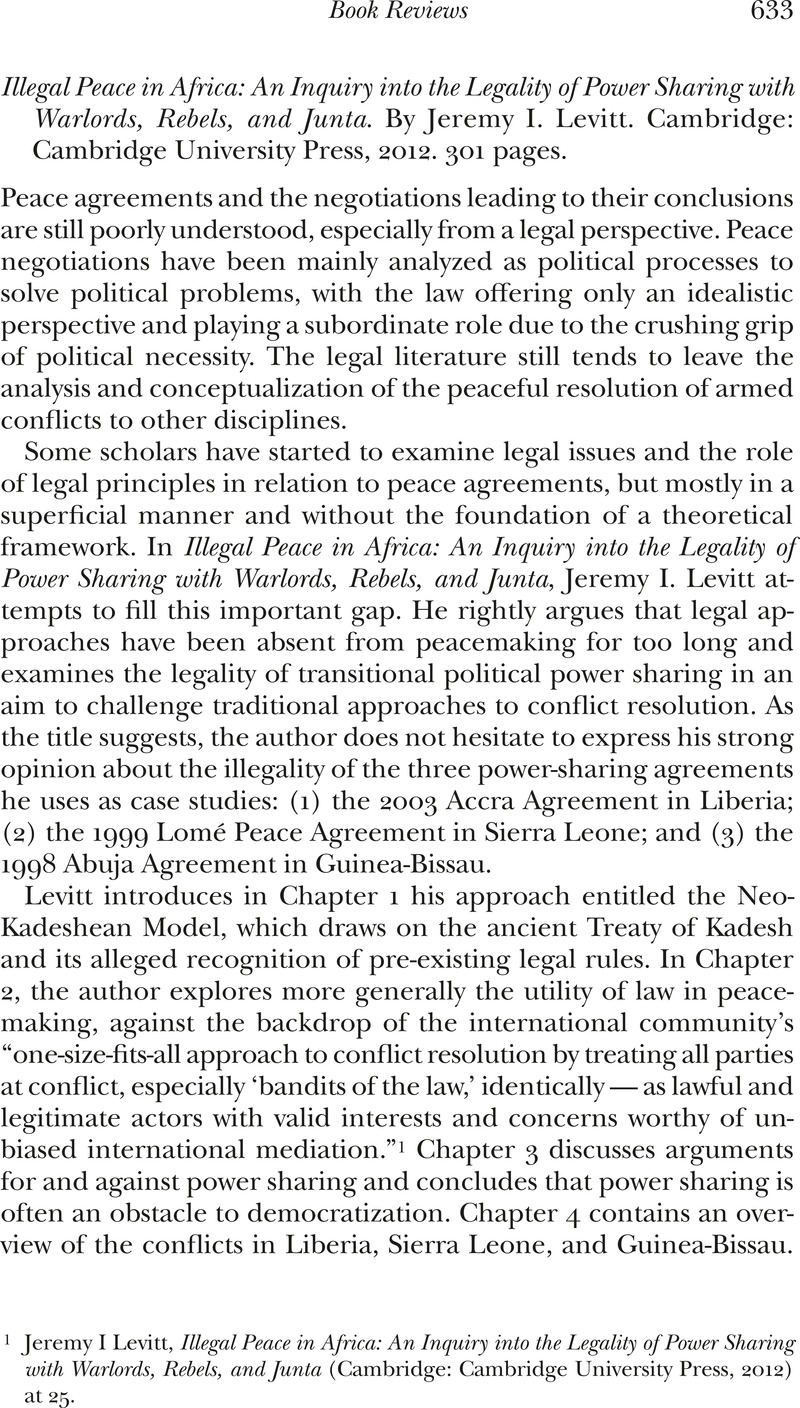No CrossRef data available.
Article contents
Illegal Peace in Africa: An Inquiry into the Legality of Power Sharing with Warlords, Rebels, and Junta. By Jeremy I. Levitt. Cambridge: Cambridge University Press, 2012. 301 pages.
Published online by Cambridge University Press: 09 March 2016
Abstract

- Type
- Book Reviews / Recensions de livres
- Information
- Canadian Yearbook of International Law/Annuaire canadien de droit international , Volume 50 , 2013 , pp. 633 - 640
- Copyright
- Copyright © The Canadian Council on International Law / Conseil Canadien de Droit International, representing the Board of Editors, Canadian Yearbook of International Law / Comité de Rédaction, Annuaire Canadien de Droit International 2013
References
1 Levitt, Jeremy I, Illegal Peace in Africa: An Inquiry into the Legality of Power Sharing with Warlords, Rebels, and Junta (Cambridge: Cambridge University Press, 2012)CrossRefGoogle Scholar
2 Ibid at 16.
3 Ibid at 9.
4 See, for example, Bryce, Trevor, “The ‘Eternal Treaty’ from the Hittite Perspective” (2006) 6 Google Scholar British Museum Studies in Ancient Egypt and Sudan 1, online: British Museum <http://www.britishmuseum.org/pdf/6a%20The%20Eternal%20 Treaty.pdf>.
5 Peace Agreement between the Government of Sierra Leone and the Revolutionary United Front of Sierra Leone, 7 July 1999, online: United Nations Peacemaker <http://peacemaker.un.org/sierraleone-lomeagreement99>.
6 Levitt, supra note 1 at 7.
7 Ibid at 31.
8 Ibid at 33–34.
9 Fuller, Lon L., The Morality of Law, rev ed (New Haven, CT: Yale University Press, 1969) at 162.Google Scholar
10 Levitt, supra note 1 at 16.
11 Fuller, supra note 9 at 193; Fuller, , “Human Interaction and the Law” (1969) 14 American Journal ofJurisprudence 1 at 27.CrossRefGoogle Scholar
12 Fuller, supra note 9 at 192.
13 Levitt, supra note 1 at 1.
14 Dayton Peace Agreement (1995), Annex 4, Article II.8 and Annex 7, Article VI.
15 Lanni, Adriaan, “Transitional Justice in Ancient Athens: A Case Study” (2010) 32:2 U Pa J Int’l L 551,Google Scholar in particular at 566–67.
16 For this argument see Fisch, Jörg, Krieg und Frieden im Friedensvertrag: Eine universalgeschichtliche Studie über die Grundlagen und Formelemente des Friedensschlusses (Stuttgart: Klett-Cotta, 1979) at 59–60.Google Scholar
17 Cassese, Antonio, “The Special Court and International Law: The Decision Concerning the Lomé Agreement Amnesty” (2004) 2 J Int’l Crim Just 1130 at 1133.CrossRefGoogle Scholar
18 Accord deLinas-Marcoussis (24 janvier 2003), Annexe (Programme du gouvernement de réconciliation), VII 5. and VI 3.
19 Levitt, supra note 1 at 47.
20 Ibid at 3, n 4 and 5.
21 Ibid at 181, 188.
22 This language draws on Teitel, Ruti, Transitional Justice (Oxford: Oxford University Press, 2000) at 214.Google Scholar Teitel argues that it would be erroneous to give too much emphasis to the stabilizing function of law in the context of societies in transition and that “law’s function in these periods is largely symbolic” (at 219, 221).
23 For this argument, see also Bell, Christine, Human Rights and Peace Agreements (Oxford: Oxford University Press, 2003) at 314 CrossRefGoogle Scholar; Slaughter, Anne-Marie, “Pushing the Limits of the Liberal Peace: Ethnic Conflict and the ’Ideal Polity’” in Wippman, David, ed, International Law and Ethnic Conflict (Ithaca, NY: Cornell University Press, 1998) 128.Google Scholar




